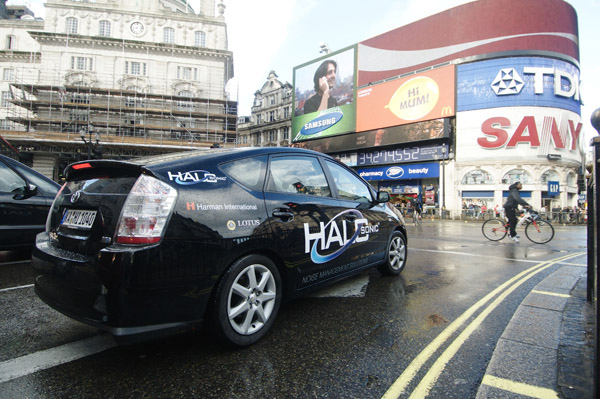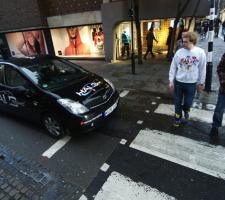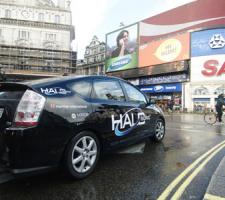
Harman’s HALOsonic technology offers significant improvements in safety for hybrids in urban environments
The growing popularity of hybrids and electric vehicles gives rise to new safety issues in urban environments, as many of the aural cues associated with engine noise can be missing. The solution is to intelligently make vehicles noisier
The rise in popularity of hybrids and Electric Vehicles (EVs) is a result of environmental pressures, shifts in taxation and emerging technologies for batteries and motors. Competition among the car manufacturers means these vehicles need to be cost effective to buy and operate, plus fun and rewarding to drive. These requirements are often in direct conflict with each other and can be further compromised by consumer desires for acceptable levels of noise and comfort.The result is an affordable and increasingly popular vehicle offering nearsilent running which is ideally suited for use in town and city. However, there is a growing concern that these vehicles are difficult to hear, thus increasing the risk of accidents.
A growing risk
According to the USWith compelling evidence, legislation was inevitable. In January this year, President Obama signed the Pedestrian Safety Act (S. 841). Introduced by Senator John Kerry, the new US law directs NHTSA to determine "performance requirements for an alert sound that allows blind and other pedestrians to reasonably detect a nearby electric or hybrid vehicle operating at low speeds". Crucially, the law will require that the vehicle generate the sound automatically and driver-initiated sounds found on the
The US may have been first but Europe and Japan, the country with the most hybrids, are working on their own legislation. The Japanese in fact released guidelines for external sound for quiet vehicles in 2010, stipulating an 'enginelike' sound.
Cost-effective solution
With the numbers of hybrids and EVs set to grow and an ambitious target set by President Obama to have one million plug-in vehicles on the road by 2015, a scalable and cost-effective solution is required by car makers. The most advanced solution is currently provided by leading acoustics and vehicle electronics specialists Harman in partnership with Lotus Engineering. DubbedUsing inputs from throttle position and vehicle speed, a central processor generates an authentic engine-like sound that is played back through a speaker in the front bumper and through the car's conventional audio system.
"The system is about generating a sound, not noise pollution," says Harman's director of active noise control, Jon Lane. "The speaker is placed at the front of the car so it can be heard from farther away but also so the sound decays much more quickly than that from an internal combustion engine. We therefore offer the best of both worlds for sound." Sound maps undertaken by Lotus present an interesting view of where sound is generated in a car and the ability through technology to fine tune this. Ensuring sound is further reduced to minimal levels, the system can be turned off at around 50km/h because tyre and road noise take over as the primary sound source(s).
The sound processor mimics the petrol engine's pitch and frequency, so pedestrians can identify the vehicle's speed, direction and distance.
"We have worked hard with organisations to ensure that the characteristics are as authentic as possible," adds Lane. "A synthesised engine noise is currently the most recognisable sound for a vehicle to make, as recommended in the recent Japanese guidelines. If the sound is not 'engine-like' pedestrians and other city dwellers could be subjected to a confusing and distracting array of sounds that could be very unpleasant and ones that the brain doesn't compute as traffic."
Defining the mix
"From a pedestrian recognition point of view, the mix of high- and low-frequency sounds that a normal engine makes is quite important," says Colin Peachey, group chief engineer at Lotus Engineering."Low-frequency sound, 50-100hz, travels farther so you get an early warning. But high-frequency sound is associated with where the sound is coming from; it's more directional." For the partially sighted and their guide dogs, this is especially true. It's a sentiment backed up by the Royal London Society for the Blind. "If a blind person wishes to cross a road, they will use sound as their main navigation aid," says Dr Tom Pey, the Society's chief executive. "The most common form of road accident involving blind people is collisions with bicycles, because the bicycle is the most difficult thing to hear. Without a simple modification to electric cars, we face even more dangers."
Intelligent options
Harman has carefully analysed the duty cycle of the electric powertrain to develop an intelligent system that creates the appropriate sound."We have implemented an engine 'idle' sound when the vehicle is switched on and the handbrake is released as this is when the vehicle is ready to move," says Lane. "A reversing sound can also be specified." At the Geneva Motor Show in April a new HALOsonic derivative using a single camera was shown. A significant advance, the camera can determine the distance, trajectory and speed of pedestrians and other road users, calculating the risk of collision by comparing this information with the car's path. Using this data, the HALOsonic system can actively control the volume of the sound to warn those pedestrians in close proximity rather than generate sound whenever the car is running. This version of the system showcased the option to generate an audible and visual warning for the driver in the cockpit with messages displayed on the dashboard or a head-up display.
Beyond safety
Harman has been actively presenting the technology to everyone from schoolchildren to vehicle manufacturers to refine the system requirements for each market and territory. Whilst legislation is likely to mandate a minimum sound level, some car manufacturers are considering introducing the technology regardless of legislation."Whilst safety is the key driver for the change, manufacturers are also seeing it as an opportunity to use the sound to convey brand characteristics," says David Howlett from MMR Research, an organisation which has conducted significant consumer research in this area. "By having sophisticated sound synthesis capability within the car, it becomes possible to develop soundbased sensory signatures which can be active within or even outside the car." Others suggest that the internal sounds could become as fashionable as cell phone ringtones, with the ability to download new ones on a regular basis.
Commercial applications
Whilst most of the development has been done using passenger cars, the sound synthesis technology is relevant to the growing number of light commercial EVs used for pick-up and delivery operations in urban environments. Often used at unsociable hours of the day, operators have increasingly preferred EVs for their quieter running and 'green' marketing benefits."We have spoken to operators about installing sound synthesis systems for their EV fleets," adds Lane. "They will be equally affected by the legislation so they could present themselves as forward-thinking and safety-conscious."
Technology ready
As one of the first companies to develop the technology and have it ready for mass production at an affordable level, it is perhaps unsurprising that Harman will have a European vehicle manufacturer launching the technology on a road car later this year."We've been able to develop and supply robust components that will meet the rigorous standards set by the OEMs," concludes Lane. "We have demonstration cars available in Europe, the US and Japan for those interested in how the technology works in the real world. As legislation seems ever more likely in these key markets, it is vital that we gather and input the opinions and desires of everybody likely to be affected. We welcome comment and feedback from those in the transport infrastructure network as to the effects of this technology."







